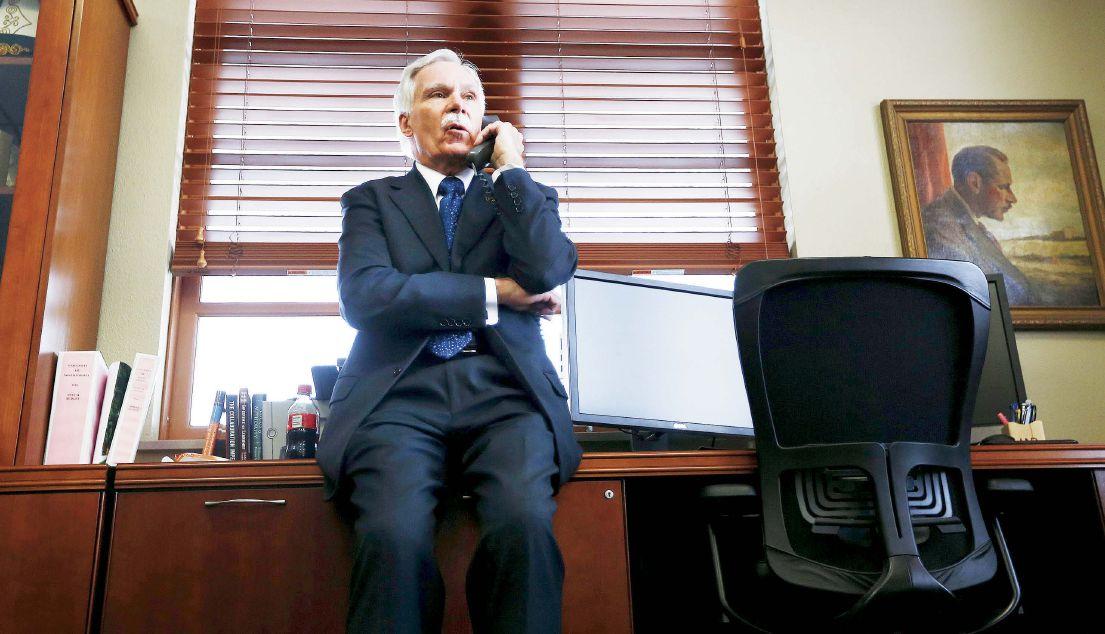
3 minute read
Preparing the Launching Pad
UND Interim President Ed Schafer uses experience to ready the university for next president
BY KAYLA PRASEK
When Ed Schafer was growing up, his father’s company, Gold Seal Co., was always part of his life. He started working in the mailroom of the Bismarck, N.D., company when he was 14, but never planned on going back when he left to attend the University of North Dakota in Grand Forks.
Schafer ended up working for his father for 15 years, with nine of those years spent leading the company. After Gold Seal was sold in 1986, Schafer launched several businesses, including a commercial real estate development company, a fish farm and a classic car dealership. Schafer served as governor of North Dakota from 1992 to 2000 and as the 29th Secretary of the U.S. Department of Agriculture under President George W. Bush. In 2000, he co-founded Extend America and served as CEO before selling the company to Sprint.
On Jan. 15, 2016, Schafer became interim president of UND, a role he says he “didn’t expect to do.” When he first heard the State Board of Higher Education would be seeking an interim president, “I pretty much dismissed it because I’m not one to be a placeholder,” Schafer says. His wife, Nancy, told him this could be a chance to get involved for a short amount of time. Schafer, along with SBHE Chair Kathleen Neset and Chancellor Mark Hagerott, set parameters defining what that “interim” title would mean, and once Schafer was convinced it would be a “decision-oriented” six months of work, he agreed to take on the role.
“When you look at the presidency of the university, everything I’ve done to this point fits,” Schafer says. “I’ve worked for government. I’ve worked for the private sector. Everything came together and fits for what’s going on and what needs to be done here.”
As interim president, Schafer says his “major vision” is to “prepare the launching pad for the rocket of a new president.” With a new nickname, logo, president and budget, Schafer says UND feels like a new university. “My job is to build the foundations of that so the new president can, over a long period of time, create the new university.”

While he works to prepare UND for a new president, Schafer is also acknowledging things UND, and universities in general, could be doing better. “There are a lot of challenges facing higher ed. There is a mismatch of the business community and the product of the university. Some of it is perceived, some is anecdotal and some is real. Businesses are saying universities aren’t meeting their needs, which is happening amidst a cultural change. There’s a big challenge in understanding the needs of the business community and to be able to teach and shape students to fit those needs off-campus. Building the engaged student in the community and the workforce for the future is a big challenge for the university system.”
Schafer says universities nationwide have also gone a long time without having to deal with basic structural issues, instead raising tuition to cover everything and limping along when necessary. “Today, we see our federal government that is incapable of providing any kind of reasonable revenue streams, or even any attention or policy, for the higher ed system. We’re facing challenges in every state’s economy and challenges in how to finance higher ed. It’s gotten to … the breaking point. … For the first time, we’ve gotten to the point where the finances of the participants in higher education are not matching the expectations of the institutions. … You have a challenge of, how do you reshape a university system to fit within the financial parameters of our culture and our society.”
Public universities face a challenge of building ethics and morals into their students, something private institutions are instilling in their students and businesses are saying their new employees don’t have, Schafer says. “That’s going to be a challenge (for public universities) to meet for the future workforce out there.”
Schafer says there is also “pressure on universities to move away from liberal arts to big data generation and technology — where our culture is going, with the iPhone culture. There has to be a match in what workforce needs are and what a university turns out, but you can’t do it by abandoning the overall education of a student. If we’re going to engage students in a community, you want them to have that liberal arts appreciation. There’s the workforce pressure not to do that, but then you’re only getting a worker, not someone who’s engaged in the community.” PB
Kayla Prasek Staff Writer, Prairie Business 701.780.1187 kprasek@prairiebusinessmagazine.com










